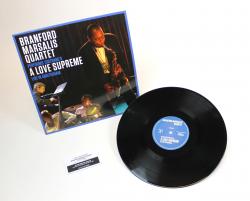 Coltrane’s A Love Supreme: Live in Amsterdam reissue from the Branford Marsalis Quartet out now and available on vinyl for the very first time Read more »
Coltrane’s A Love Supreme: Live in Amsterdam reissue from the Branford Marsalis Quartet out now and available on vinyl for the very first time Read more »
Bilingual Rhythms: Drummer Henry Cole combines postbop and plena
A lot of music has been played since Chano Pozo’s grooves confounded jazz drummers playing at his side. Still, blending traditional Afro-Caribbean rhythms and standard notions of swing remains a challenge, one that drummer Henry Cole didn’t take lightly.
To learn the rhythmic vocabulary of plena and bring it into the language of jazz, Cole, who, like saxophonist Miguel Zenón, is from Puerto Rico, says he was “actually pretty conservative, a bit of a traditionalist. What I mean by that is that I wasn’t listening to drummers who played plena, but to back-alley, street plena players. And when I was listening to jazz, I was listening to the old masters. So when I came to mix traditions I mixed more of the classic sound.”
Cole was not new to plena. He was born near Mayaguez, a city west of San Juan with a deeply rooted plena tradition. “It was always in the air. And in the end, you learn it by osmosis,” he says. “It’s a party music. There is a generation that has followed the tradition but it’s not something that is commercial.”
He played plena in Puerto Rico as a member of salsa groups, and in New York with the contemporary plena group Viento de Agua, but always behind the drum kit. “Yeah, I know how to play pandero, but I’m not very good,” he says with a sigh and a chuckle. “I’m the guy with sticks. Playing with bare hands is a different technique.”
As it turns out, the quartet did not do any special preparation for this recording. “Hans [Glawischnig], our bass player, has played with David [Sanchez] in projects like Melaza. [Pianist Luis] Perdomo has played Afro-Caribbean music all his life and Miguel and I both like this music and listen to it as music fans, not just because we are trying to mix it with jazz,” explains Cole. “Of course, when Miguel brought in the music there were specific challenges, but we were all familiar with the sound.”
One of the challenges was that Zenón di not think of the group for Esta Plena as his band simply augmented by three percussionists. Rather, Zenón says, “I almost thought of the project as having two bands: the regular jazz quartet and the ‘street’ guys playing their drums and singing-and having those two bands going at the same time.”
“It was incredible how Miguel wrote around the panderos [single-head, handheld drums],” adds Cole. “And it was especially interesting that we had to play around them. You usually have a percussionist in a jazz group, and they try to accommodate their work around the music. Here they are not accommodating anything; they are playing, and we are the ones who have to interact with what they do.”
Some jazz drummers, perhaps most notable-and most successfully-Cuban drummer Horacio “El Negro” Hernandez, have translated congo patterns (in rumba, for example) to the drum kit. In some instances on Esta Plena, Cole does suggest the groove of a pandero, such as on the title track. There, Cole’s playing evokes the variations of a pandero requinto. “The point is not to imitate, but to play in the language,” says Cole.
He continues, “If you listen to those styles that feature three drums, there is always one that’s high pitched and repica [plays variations], and one that is low-pitched and sets the basic pattern. It’s what happens in rumba, it’s what happens in samba and that’s what happens in plena.
“But if you hear someone like Kenny Clarke, for example, he does the same thing in jazz, only that he does it with the snare drum and the bass drum. Again: high and low. And that’s the link. And that’s how I worked the language of plena with in the jazz tradition. That way I could give it the right sound-without getting gin the way.”
Still, for all the technical challenges and the forced innovations, what truly excites Cole about Esta Plena is that it’s danceable.
“There are some musicians today who consider themselves jazz musicians and would never go play a dance gig,” says Cole. “Or, if you take a musician who plays dance music, he would never go to hear a jazz show because he’d find it very boring. Something I find important in this project is that it brings those worlds together. The music goes along and then there is an incredible solo with a section in 9/8 or whatever, but it goes right back to the danceable rhythm and the singing.
“It might sound easy but there are very complicated elements to the songs, time signatures, harmonies. But, I don’t think you’ll remember the song because of that. A friend of mine told me, ‘Miguel plays dance music, and then, there’s a moment when he sticks el veneno [“the poison”], and then he goes back to the dance music’ And I laughed when he said it, but you know what? I thought about it, and he’s on to something.
Categories
Tags in Tags
Branford Marsalis Branford Marsalis Quartet ellis marsalis four mfs playin' tunes Joey Calderazzo Justin Faulkner Marsalis Family marsalis music metamorphosen miguel zenon music redeems new orleansFilter by Artist
Marsalis Music Radio
Join Our Mailing List
- RT @bmarsalis: Compliments of the @T_Blanchard archives. https://t.co/4RsXbyEloa — 2 years 2 weeks ago MarsalisMusic